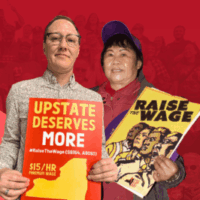Last week, Wisconsin Gov. Tony Evers (D) vetoed a dangerous bill. Disguised as a way to provide so-called “portable benefits” to app-based workers, the bill was a corporate gimmick designed to exclude app-based ride-hailing and delivery workers from state employment rights such as minimum wage, workers’ compensation and unemployment insurance.
Backed by major companies like Uber, Lyft and DoorDash, these portable benefits bills are popping up around the country as part of a larger effort to legitimize business models based on misclassifying employees as independent contractors and avoiding accountability to their workers and the public.
Portable benefits bills are popping up around the country as part of a larger effort to legitimize business models based on misclassifying employees as independent contractors.
Whereas workers would gain little, corporations stand to gain a lot. By classifying their workers as independent contractors, these corporations can skip out on complying with minimum wage and overtime protections.
They can also avoid providing employment-based benefits such as paid leave, health insurance, workers’ compensation and unemployment insurance — benefits that are standard for their corporate employees.
Now, in exchange for excluding workers from employment rights and benefits, the companies could, but would not be required to, offer these workers portable benefits — glorified savings accounts with minimal company contributions.
But corporations don’t need a law to set up these portable benefits programs. DoorDash voluntarily started a portable benefits savings account program in Pennsylvania, and it provides us with all we need to know about how these programs operate.
DoorDash’s report on the Pennsylvania program found workers contributed an average of $6 to their portable benefits savings accounts, and DoorDash contributed an average of $31 per month to each account — a minuscule amount to cover benefits like health insurance and paid time off.
And savings accounts are no substitute for insurance-based benefits, like workers’ compensation and unemployment insurance, that help people weather emergencies that would otherwise be financially catastrophic.
Instead of savings accounts set up by the corporations, app-based workers should receive the same portable benefits that other employees are entitled to, like unemployment insurance and Social Security.
Wisconsin set the right example by rejecting Big Tech’s attempts to write its own laws and avoid the obligations that all other employers have to their workers, but this is not the end of this fight.
The corporations are lobbying in other states for similar legislation that legitimizes their fake portable benefits programs and their business model built on denying the workers central to their operations employment rights and protections.
Congress, as well, is considering a bill that would make it easier to classify workers as non-employees and exclude them from federal minimum wage, overtime protections and the right to collectively bargain.
Control without responsibility is the guiding framework for corporations like Uber, Lyft, and DoorDash. By using algorithms and apps to surveil, discipline and reward their workers, these companies exert control in more exacting ways than any human boss could, even as they disclaim responsibility for the workers powering their businesses.
The algorithms determine which assignments are offered to whom, what workers are paid and whether they are “deactivated” — industry speak for suspensions or firings.
Even the scheduling flexibility touted by the corporations is limited by systems that make working on the app like a game, nudging workers into working more or at particular times and accepting specific assignments.
This model has devastating consequences for app-based workers. Studies show rides-hail and delivery workers earn poverty-level wages, often below the local minimum wage.
And, despite the serious health and safety risks associated with driving and delivery work, they have no employment-based benefits if they get sick or injured. Studies show app-based workers depend on public programs like Medicaid and SNAP at higher rates than employees.
The model also harms customers. Over five years, over 400,000 Uber trips resulted in complaints to the company of sexual assault or sexual misconduct — many of which were made by passengers against Uber drivers.
Uber has refused to implement safety measures because it does not want to be liable as an employer. By arguing that it isn’t responsible for the conduct of its “independent contractors,” Uber increases the likelihood of sexual assault.
It’s time for lawmakers to hold these companies accountable. Instead of savings accounts set up by the corporations, app-based workers should receive the same portable benefits that other employees are entitled to, like unemployment insurance and Social Security.
We should bolster these programs by adequately funding them (including requiring app-based corporations to contribute to them like other employers do), eliminating barriers to access and increasing benefits amounts.
Policymakers should pass portable paid leave laws that allow workers to accrue paid leave and carry it from job to job. The nation should also expand tested models for providing portable benefits to gig workers.
Multi-employer benefits plans are negotiated between unions and employers for gig workers like writers and construction workers. Workers accrue benefits during each gig worked, and employers pool contributions into a fund that provides health insurance and retirement benefits.
The same model could provide benefits for ride-hailing and delivery workers and would be more meaningful than a fake portable benefits program.
At a time when tech has growing influence over our politics, we cannot allow these app companies to manipulate our laws and weaken worker protections. These portable benefits gimmicks should be seen for what they are — wolves in sheep’s clothing.
Laura Padin is director of Work Structures at the National Employment Law Project.
###
This commentary was originally published at thehill.com.


